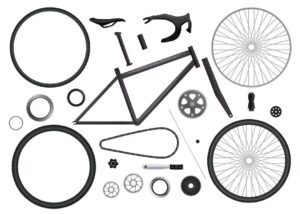Una bicicleta ligera ofrece mayor agilidad, maniobrabilidad mejorada, y mayor eficiencia, permitiendo a los ciclistas conquistar diversos terrenos con mayor facilidad y disfrute. Ya sea que estés afrontando desafiantes senderos de montaña, Navegando por las bulliciosas calles de la ciudad., o apuntar a la velocidad en carreteras abiertas, El peso de tu bicicleta juega un papel crucial en tu rendimiento y experiencia general.. Pero, ¿qué constituye exactamente una bicicleta ligera?? ¿Cuál es la mejor bicicleta ligera para ciclistas?? En este artículo, Te explicaremos detalladamente el peso de la bicicleta.. Así que espera qué? Profundicemos en el conocimiento de la bicicleta.
¿Cuál es el peso promedio de una bicicleta??
Cuando se trata de peso, Comprender el peso promedio de diferentes tipos de bicicletas puede ayudarlo a tomar una decisión informada.. Profundicemos en los distintos pesos medios de las bicicletas:
Peso promedio de una bicicleta de montaña
De término medio, bicicletas de montaña pesar entre 9.5-13.1 kg. Estas bicicletas están diseñadas para manejar terrenos accidentados y diferentes condiciones de senderos., lo que puede contribuir a su construcción ligeramente más pesada en comparación con otros tipos de bicicletas.

Peso medio de una bicicleta de carretera
Para bicicletas de carretera, Más ligero a menudo se percibe como mejor., especialmente para fines de escalada. Una bicicleta de carretera de alta gama suele pesar alrededor 6.8-7.7 kg (15-17 libras), mientras que los modelos de gama media pueden variar desde 8.1-10 kg (18-20 libras). El diseño aerodinámico y el énfasis en la velocidad en las bicicletas de carretera a menudo prioriza un cuadro más ligero.

Peso medio de una bicicleta urbana
bicicletas urbanas, También conocidas como bicicletas urbanas o de cercanías., generalmente se encuentran dentro de un rango de peso moderado para los desplazamientos diarios por la ciudad y los viajes de placer. Si bien los datos específicos pueden variar debido a los fabricantes’ discreción, Estas bicicletas suelen pesar alrededor 8.32 kg (18.34 lbs) de término medio. Puede guiar su selección según el uso previsto y las preferencias comprendiendo los pesos promedio de los diferentes tipos de bicicletas para desplazamientos diarios..

Peso medio del scooter
El peso del scooter es crucial en su agilidad y facilidad de uso.. De término medio, Los scooters exhiben un espectro de peso que se adapta a diferentes preferencias y funcionalidades.. En los últimos años, Se ha notado la tendencia hacia los scooters ligeros.. Las bicicletas profesionales registraron un peso promedio de solo 7.04 kg allá por 2015, con escalada especializada’ bicicletas aún más ligeras con 6,99 kg. Pero ahora los scooters suelen variar desde 3.6-5.4 kg (8-12 libras), con variaciones según el diseño y el uso previsto. Este énfasis en el peso reducido se alinea con la búsqueda de mayor velocidad y maniobrabilidad.. Por ejemplo, a 7 kg de scooter a un 9 kg tiene una importancia 29% diferencia de peso. Si bien levantarlos puede mostrar claramente este contraste, Las superficies de impacto reales durante los paseos., Especialmente en subidas cuesta arriba donde el peso total del sistema influye en el rendimiento. (manejo y aceleración).

¿Cuál es un buen peso para una bicicleta??
Al considerar el peso de una bicicleta, Determinar qué constituye un peso óptimo puede afectar significativamente su experiencia de conducción.. Exploremos los pesos ideales para diferentes tipos de bicicletas para ayudarle a tomar una decisión informada.:
Un buen peso para una bicicleta de montaña
Un buen peso para una bicicleta de montaña suele oscilar entre 11-14 kg (25-30 libras). Este rango de peso logra un equilibrio entre durabilidad y agilidad para terrenos todoterreno.. Bicicletas de montaña más ligeras, alrededor 11.3 kg (25 libras), A menudo se prefieren por su maniobrabilidad en senderos técnicos., mientras que los modelos un poco más pesados, arriba a 13.6 kg (30 libras), Ofrece mayor estabilidad y resistencia para terrenos accidentados y descensos..
Un buen peso para una bicicleta de carretera
Para una bicicleta de carretera ligera, un peso ideal se sitúa entre 6.8-9 kg (15-20 libras). Las bicicletas de carretera más ligeras son apreciadas por su eficiencia y velocidad en superficies pavimentadas.. Las bicicletas de carreras profesionales suelen pesar más 6.8 kg (15 libras), Permitir a los ciclistas acelerar rápidamente y mantener altas velocidades.. Sin embargo, bicicletas de carretera que pesen hasta 9 kg (20 libras) puede proporcionar mayor durabilidad y comodidad para viajes de larga distancia sin sacrificar demasiada velocidad.
Un buen peso para una bicicleta urbana
Las bicicletas urbanas suelen pesar alrededor 11-16 kg (25-35 libras). Estas bicicletas priorizan la comodidad y la versatilidad para los desplazamientos urbanos. Mientras que las bicicletas urbanas más ligeras, como bicicletas plegables ligeras, Ofrecen una maniobrabilidad más fácil en el tráfico y al navegar en espacios reducidos., Los modelos ligeramente más pesados pueden proporcionar mayor estabilidad y resistencia., especialmente para transportar cargas o circular por calles urbanas difíciles.
Un buen peso para un scooter
Los scooters generalmente pesan entre 9-14 kg (20-30 libras). Como una de las bicicletas livianas para damas y hombres., este rango de peso tiene portabilidad y estabilidad para viajes de corta distancia. Patinetes más ligeros, alrededor 9 kg (20 libras), son más fáciles de transportar y maniobrar, haciéndolos ideales para viajes cortos o navegar en áreas concurridas. scooters más pesados, arriba a 14 kg (30 libras), puede ofrecer mayor estabilidad y durabilidad, especialmente para desplazamientos diarios o conducción sobre superficies irregulares.
Además, Tener en cuenta la capacidad de apoyo del ciclista es crucial para determinar el peso adecuado del scooter.. El patinete eléctrico S1, por ejemplo, pesa 53 libras mientras soporta a pasajeros de hasta 300 libras.
Del lado de fabricantes de bicicletas, algunos suelen establecer límites de peso para los scooters para mantener un rendimiento óptimo y estándares de seguridad. Criterios como una capacidad máxima de peso de 220 libras manteniendo el peso del scooter en 40 libras o menos Destacar el compromiso de la industria con el diseño centrado en el usuario..
¿Qué hace que una bicicleta sea liviana??
Por qué una bicicleta ligera es tan ligera? Esta pregunta puede confundir a muchos ciclistas.. Ahora sigue leyendo y explora los factores que influyen en el peso..
Selección de materiales y construcción.
La elección de los materiales influye significativamente en el peso de una bicicleta.. Los fabricantes suelen optar por materiales ligeros pero duraderos, como aluminio, fibra de carbono, y titanio construir marcos, horquilla, y componentes.
- Aluminio: Conocido por su naturaleza liviana y asequibilidad., Los cuadros de aluminio prevalecen en las bicicletas de nivel básico y de gama media.. Ofrecen un buen equilibrio entre peso y durabilidad., haciéndolos ideales para diversas condiciones de conducción.
- Fibra de carbono: Reconocido por su excepcional relación resistencia-peso., La fibra de carbono se prefiere en bicicletas de alta gama debido a su capacidad para reducir el peso sin comprometer la rigidez o el rendimiento.. Este material permite diseños complejos que optimizan la aerodinámica y el confort..
- Titanio: Aunque menos común que el aluminio o la fibra de carbono., Los marcos de titanio son apreciados por su durabilidad., resistencia a la corrosión, y ligereza. Mientras que las bicicletas de titanio tienden a ser más caras, Ofrecen una calidad de marcha única buscada por muchos ciclistas..
Selección de componentes
Aparte de los materiales del marco., La elección de los componentes también juega un papel crucial a la hora de determinar el peso total de una bicicleta.. Componentes como ruedas, tren motriz, bigote daliniano, y sillas de montar Contribuir significativamente a la masa de la bicicleta..
- Ruedas: Las ruedas livianas fabricadas con materiales como fibra de carbono o aluminio de alta calidad reducen el peso rotacional., mejorando la aceleración y la maniobrabilidad.
- Transmisión: Optar por componentes de transmisión de alta calidad, como desviadores y casetes fabricados con aleaciones ligeras, puede reducir aún más el peso total de la bicicleta y, al mismo tiempo, garantizar cambios de marcha suaves..
Optimización del diseño
Los fabricantes emplean técnicas de diseño avanzadas para optimizar las estructuras de las bicicletas sin comprometer la resistencia o el rendimiento.. Características como tubos conificados, donde las paredes del tubo varían en espesor a lo largo de su longitud para reducir el exceso de material sin sacrificar la integridad estructural, ayudar a reducir el peso innecesario.
Impacto en el rendimiento
El peso de una bicicleta influye directamente en su rendimiento en diversos terrenos. Las bicicletas más ligeras requieren menos gasto de energía por parte del ciclista durante las subidas y aceleraciones debido a la reducción de la inercia.. Esto se traduce en capacidades de velocidad mejoradas y precisión de manejo mejorada..
Por qué la bicicleta ligera es más cara?
Al contemplar el coste de las bicicletas ligeras, varios factores entran en juego, Influir en la dinámica de precios dentro de la industria del ciclismo.. Comprender estos elementos arroja luz sobre la correlación entre el peso y el costo de la bicicleta, Guiar a los consumidores en sus decisiones de compra..
Selección de materiales e implicaciones de costos
La elección de los materiales afecta significativamente el peso de una bicicleta y, como consecuencia, su precio. Materiales ligeros pero duraderos como fibra de carbono y titanio A menudo se prefieren para bicicletas de alto rendimiento debido a su capacidad para reducir el peso total sin comprometer la integridad estructural.. Sin embargo, Estos materiales avanzados tienen un costo superior., Contribuyendo a los precios más altos asociados con las bicicletas más livianas..
A diferencia de, bicicletas construidas con materiales más comunes como aluminio puede ofrecer un equilibrio entre reducción de peso y asequibilidad. Si bien los marcos de aluminio son livianos y rentables, Es posible que no alcancen el mismo nivel de ahorro de peso que la fibra de carbono o el titanio., lo que resulta en un rango de precios moderado en comparación con sus homólogos de gama alta.
Mejoras de rendimiento e innovaciones tecnológicas
Las bicicletas livianas a menudo incorporan tecnologías de vanguardia e innovaciones de diseño destinadas a optimizar métricas de rendimiento como la velocidad., agilidad, y aerodinámica. Características como formas aerodinámicas del marco., sistemas integrados de guiado de cables, y los componentes de suspensión avanzados contribuyen a mejorar las experiencias de conducción, pero también aumentan los costos generales de producción..
Los fabricantes invierten mucho en investigación y desarrollo para perfeccionar estos avances tecnológicos., superando los límites del diseño de bicicletas para ofrecer capacidades de rendimiento superiores. Estas innovaciones se traducen en mayores costes de producción que se reflejan en los precios finales de venta al público de las bicicletas ligeras en comparación con los modelos estándar..
Demanda de mercado y posicionamiento de marca
La demanda de bicicletas ligeras entre los entusiastas del ciclismo impulsa la tendencia del mercado hacia la producción de modelos ligeros de primera calidad que se adapten a preferencias de conducción específicas.. Las marcas que se posicionan como líderes en tecnología de bicicletas livianas a menudo exigen precios más altos debido a su reputación de calidad artesanal e innovación..
Los consumidores que buscan un rendimiento de primer nivel y experiencias de conducción incomparables están dispuestos a invertir en bicicletas ligeras y costosas que ofrezcan un manejo superior., sensibilidad, y ventajas de velocidad. Esta dinámica de oferta y demanda influye en las estrategias de precios dentro de la industria., con modelos premium livianos ubicados en un nivel de precio más alto en comparación con las opciones de bicicletas convencionales.
Opciones de personalización y funciones de personalización
Los fabricantes de bicicletas ligeras suelen ofrecer opciones de personalización que permiten a los ciclistas adaptar su experiencia en bicicleta según sus preferencias individuales. Desde seleccionar componentes específicos como ruedas ultraligeras o manillares de fibra de carbono hasta acabados de pintura personalizados o accesorios personalizados., Estas características adicionales contribuyen al costo total de las bicicletas livianas.. Si bien estos toques personalizados realzan la exclusividad de las bicicletas ligeras, También incurren en gastos adicionales que contribuyen a su estructura de precios premium..
Conclusión
En resumen, El concepto de bicicleta liviana abarca más que solo números en una escala: encarna la esencia del rendimiento., versatilidad, y disfrute en bicicleta. Del ciclismo de montaña a los desplazamientos urbanos, No se puede pasar por alto la importancia del peso de la bicicleta.. Reconociendo las funciones de una bicicleta liviana y entendiendo su rango de peso óptimo para diversas disciplinas de conducción., Los ciclistas pueden tomar decisiones informadas que mejoran su experiencia de conducción y maximizan su potencial en la carretera o sendero..
Preguntas frecuentes
Es 30 libras de peso para una bicicleta de montaña?
Sí, es relativamente pesado. Sin embargo, según un técnico de bicicletas, una bicicleta de montaña que pesa 30 Las libras pueden ofrecer robustez y maniobrabilidad.. Este rango de peso garantiza que la bicicleta pueda soportar terrenos accidentados y al mismo tiempo brindar control en senderos desafiantes..
Es 25 Libras ligeras para una bicicleta?
Sí, 25 Libras se consideran ligeras para una bicicleta., Especialmente para ciertos tipos, como bicicletas de carretera y de montaña.. Las bicicletas más ligeras suelen ser más fáciles de transportar, almacenar, y ascensor en situaciones de tráfico, Mejorar la comodidad general para los ciclistas que buscan agilidad y capacidad de respuesta..
Lo que se considera ligero para una bicicleta de montaña?
Un rango de peso de aproximadamente 22 a 28 libras por una bicicleta de montaña generalmente se consideran livianas. Las bicicletas de esta gama ofrecen mayor agilidad, maniobrabilidad, y eficiencia, haciéndolos ideales para afrontar senderos desafiantes y maximizar el rendimiento en terrenos todoterreno.
¿De qué están hechas las bicicletas de carretera más ligeras??
Las bicicletas de carretera más ligeras suelen estar hechas de fibra de carbono, aleaciones de titanio, y aluminio de alta calidad, Reconocido por su excepcional relación resistencia-peso.. Estos cuadros y componentes pueden reducir el peso total de la bicicleta mientras mantienen la rigidez y la capacidad de respuesta para un rendimiento óptimo en la carretera..

















